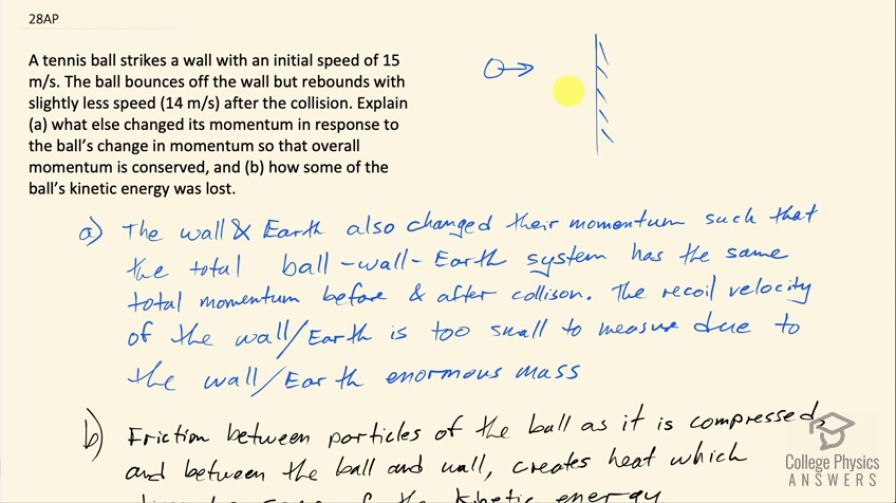Question
A tennis ball strikes a wall with an initial speed of 15 m/s. The ball bounces off the wall but rebounds with slightly less speed (14 m/s) after the collision. Explain (a) what else changed its momentum in response to the ball’s change in momentum so that overall momentum is conserved, and (b) how some of the ball’s kinetic energy was lost.
Final Answer
Please see the solution video.
Solution video
OpenStax College Physics for AP® Courses, Chapter 8, Problem 28 (Test Prep for AP® Courses)

vote with a rating of
votes with an average rating of
.
Video Transcript
This is College Physics Answers with Shaun Dychko. A tennis ball is going to strike a wall with some initial speed— 15 meters per second— and then it bounces off the wall sometime later and it has a speed of only 14 meters per second after collision. So this is 15, this is 14 and question in part (a) is what else changed its momentum in response to the ball's change in momentum? So the ball's momentum initially was whatever its mass is multiplied by 15 meters per second positive and after collision, it's mass times negative 14 meters per second and this wall and Earth also changed their momentum such that the total initial momentum equals the total final momentum. So with the initial momentum having some amount to the right after collision with the ball going to the left and having momentum to the left, the wall must have a compensating momentum to the right such that the total equals what we had initially and this change in momentum of the wall and the Earth is so immeasurably small, we can't really notice it because the speed or the velocity of this wall and Earth would be so immeasurably small. Now what accounts for this loss in kinetic energy? So initially, we have some kinetic energy one-half mass times 15 meters per second squared and afterwards, we have one-half mass times 14 meters per second squared and so the speed is decreased and therefore the kinetic energy has decreased and how do we count for that? Well, the ball will compress when it hits the wall and there will be friction in between the particles or molecules of this material as it's compressing and there's also going to be friction between the surface of the ball and the wall as it's squishing against it and that friction will dissipate some energy in the form of heat and some energy will be dissipated in the form of sound energy too but it's mainly the heat that matters here and that's going to result in some of the kinetic energy being lost since it's been transformed into heat.